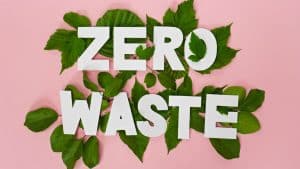Zero Waste
Best Waste Management Practices for Business Owners
by Shannon Bergstrom
 The zero waste movement is gaining steam. Green alternatives to generating waste that just ends up in landfills are available. People from across the globe are working hard to reduce, reuse, and recycle, and to live cleaner, greener lives.
The zero waste movement is gaining steam. Green alternatives to generating waste that just ends up in landfills are available. People from across the globe are working hard to reduce, reuse, and recycle, and to live cleaner, greener lives.
But it’s not just the regular Joes and Janes of the world who are investing in the zero waste and recycling. In fact, entire industries are looking into reducing the amount of waste they produce, for many good reasons.
One important step towards companies achieving their zero waste goals is the concept called the circular economy. According to this concept, a manufacturer will literally work on reducing its waste throughout the lifetime of a product. In other words, it’s meant to help reduce, reuse, and recycle raw materials from the inception stage to the landfill stage.
Now, let’s say that you’re an eager entrepreneur who wants to employ some useful zero waste practices and innovative recycling initiatives. How exactly can you go about it? Well, we’re here to help you out. In this article, we will review several of the best waste management practices for any business owner to apply, be they brand new or a seasoned CEO.
Consider Waste-to-Energy
Normally, we would recommend incineration as the absolute last resort. After all, incinerating waste has been responsible for some of the worst air pollution in many regions of the planet for decades now. So, if you, the business you work at, and/ or your company, do have to burn waste, do it selectively. And if you can, only do it if there’s a chance that it can be turned into renewable energy.
The benefits of investing in waste-to-energy (W2E) systems are significant. Several companies around the world actually do recover a lot of energy from incineration and use it to power buildings and save other raw energy resources in the process.
Measure Your Waste
This process will not exactly be easy, since you might own a huge business that tends to produce a lot of waste. But if you (and your associates) can, make sure to try and do the following:
- Weigh the trash and recycling bags from a representative sample from your building
- If you have the capacity, separate the contents within the waste bags into separate categories to determine the type of waste being generated
- Record how full waste bins are at the time of collection to see if they are being collected too often
- Make sure to share and compare the results of your waste survey with all of your business sites
Once you have all of the data, you can determine how much and what type of waste is leaving each facility. That way, you can set reasonable goals for reducing those numbers.
Donate What You Can
Businesses donate quite a lot, mainly due to positive company rep and tax deductions. After all, it’s a cost-effective way of getting rid of the things you don’t need. Why throw away working and undamaged equipment when it can go into the hands of the needy and unfortunate?
Almost anything can be donated. For example, old furniture and wardrobes can go to any local Goodwill, while different charities will gladly take any extra food. You can even donate office materials to schools and orphanages that might require them. The best way to go about it is to find a local charity organization and work out a deal regarding what you intend to donate on a weekly, monthly, or yearly basis.
The Paperless, Digital Route
On average, an office worker uses around 10,000 sheets of paper per year, and almost half of that amount ends up in the trash. Despite the technological advancements we have made, most businesses still use pen and ink for nearly all of their dealings. That’s millions of tons of paper that end up in landfills across the world every single year. The number of trees that get cut down to produce most of that paper is even bigger than that.
So, to avoid adding to the pile, you can make your business as paperless as possible. For instance, draft all contracts, addendums, deals, etc., in digital PDF files and have your employees use the cloud to store important data. When you do have to print, do so on both sheets of paper and use ‘draft mode’ while printing to save on ink expenses.
Compost Lunches
Yes, office composting is very much a thing. In fact, it’s highly recommended by many veteran green CEOs out there.
Basically, if your employees produce a lot of organic waste (food remains, banana peels, apple cores, tea bags, etc.), you should reuse it in the greenest way possible. Set up a composting station for employees to discard their organic waste rather than throwing it in the trash bins. You can then reuse the finished compost for fertilizing plants, either at home or directly at work.
Set Up Small Office ‘Waste Stations’
As we stated earlier, having a decent compost bin in your office is an excellent idea. However, by no means should you stop there. In fact, there is a perfect way you can promote recycling at the office directly.
The best way to go about it is to find a high-traffic area between offices and set up waste stations with a bin for each waste stream. Furthermore, place a handy guide about the type of waste that goes into each bin. And just to spice things up, you can incorporate green practices into the working schedule, or even offer some mid-tier awards and benefits to the workers who recycle regularly. That way, you can encourage everyone to cultivate green working practices.
Green Merch
Giveaways and merchandise are a must of any successful company. However, make sure to consider green options when you decide on how to reward your loyal customers or employees. One key step is giving them reusable items, like jute tote bags or durable drinking mugs. Another is to go all digital; you can always give your employees discounts, e-tickets to various events, or downloadable content for their PCs or smart devices. It saves you money in the long run and prevents tons of plastic and non-biodegradable material from ending up in landfills, as does using recyclable or eco-friendly digital equipment.
Best Waste Management Practices
As you can see, there are plenty of things you can do as a business owner to manage your waste better. But by all means, don’t stop there. Let this article serve as an excellent jumping-off point for further research into green, waste-free business practices.
Author Bio

Shannon Bergstrom is a LEED Green Associate, TRUE waste advisor. She currently works at RTS, a tech-driven waste and recycling management company, as a sustainability brand manager. Shannon consults with clients across industries on sustainable waste practices.